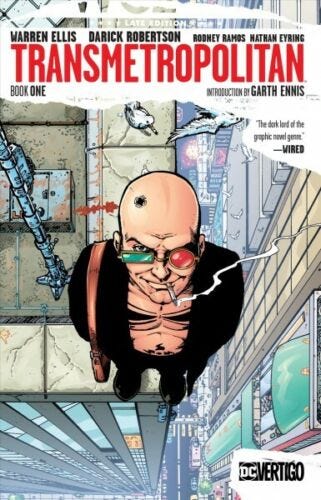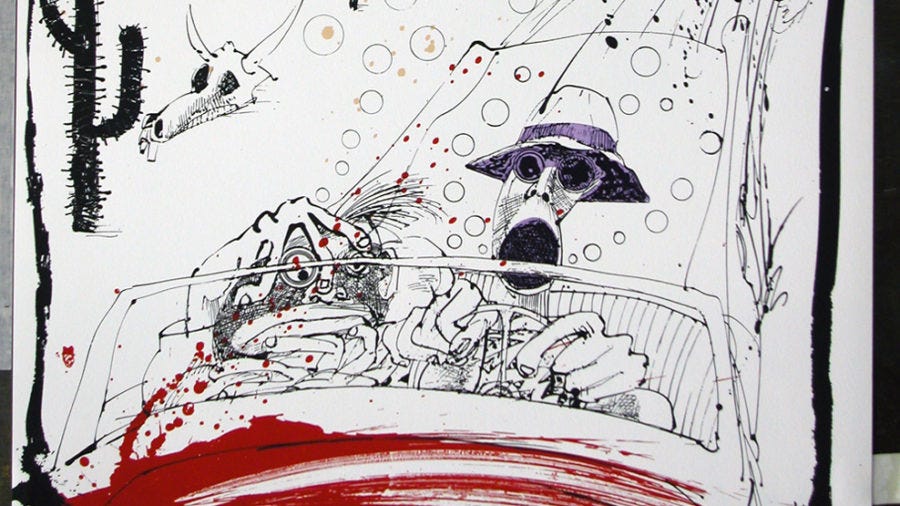My first exposure to Hunter S. Thompson, or at least the idea of Hunter S. Thompson, was through the 1998 film adaptation of Fear and Loathing in Las Vegas, which I suspect is the case for a majority of millennials.
The prevailing image of Thompson one could understandably take from Fear and Loathing was one of a reckless, drug-fueled mess of a person; an avatar for 1960s and ‘70s anti-Vietnam occupation sentiment through counter-culturalism.
My other youthful impression of Thompson came from the comic Doonesbury’s character Uncle Duke, the most thinly veiled fictionalization of a real person ever conceived and a not-exactly complimentary take on Thompson. The more loving tribute to Thompson as depicted through pen-and-ink I discovered after I was more familiar with Thompson himself, that being Spider Jerusalem of the graphic-novel series Transmetropolitan.
But whether it was Fear and Loathing’s depiction of a Nixon-era counterculture figure on hallucinogens; Doonesbury’s politically nebulous crank with a fondness for guns; or Transmetropolitan’s rabble-rousing (and honest-to-a-fault) journalist hellbent on exposing societal ills, none of the pop-culture takes on Thompson are inaccurate.
But all only cover parts of his legacy; a legacy that includes unsung contributions to what sports journalism can be.
My first exposure to Hunter Thompson without a Hollywood wasn’t through his political, satirical nor social commentary work, either. Rather, I discovered Thompson The Writer, Thompson The Journalist and parsed this figure from Thompson The Character, via ESPN all of places.
Actually, I need to backtrack on what I wrote in the previous paragraph for a moment. It’s not quite correct for me to state I wasn’t exposed to Thompson’s satire, nor his social commentary, nor his politics by reading his ESPN Page 2 column.
While Thompson ostensibly covered, or at least sometimes wrote about football for ESPN’s off-beat vertical, his entries were hardly what you would call “football columns.”
To wit, the first Thompson column I recall reading was his predictably controversial at the time but ultimately prescient forecast in the wake of 9/11.
I was 18, in just my week away from home at college, and like millions I was equal parts bewildered, terrified and vengeful. The terrorist attacks on New York and the Pentagon, and the thwarted plans of the United 93 hijackers, put a temporary hiatus on the just-started football season, but the blitz I wanted to see in the coming weeks was a blind barrage on…something.
A stance like Thompson’s seemed, in the moment, unpatriotic. That may have even been what directed me to the column in the first place, as I scoured message boards for updates on what was happening in the world and saw the link shared, angrily, in a proto form of hate-clicking.
But as the weeks turned to months and Thompson’s predictions came to fruition one-by-one, it’s readily apparent he wasn’t writing for shock value or a lack of patriotism but a healthy dose of realism.
There are three pieces of media that for me define that September day, its immediate impact on America and its fallout for the world, each for different reasons: “The Falling Man” and “Impending Death” photos are one for their unvarnished capturing of the attacks’ horrors.
Howard Stern’s broadcast from Manhattan that morning is another. Stern stayed on the air for several, uninterrupted hours and expressed many of the same knee-jerk sentiments immediately sweeping the nation.
And the third is Thompson’s column; a column on ESPN.com.
I guess it really shouldn’t be surprising Thompson expressed profound social and political insight through a sports platform, at least knowing what I know of him now. What prompted this newsletter installment was the introduction from the most recent Greatest Days in College Football deep-dive, which I led with a Thompson quote on Richard Nixon’s love of the gridiron.
Likewise, one of Thompson’s most famous works of journalism, “The Kentucky Derby is Decadent and Depraved,” uses the backdrop of Churchill Downs to illustrate social unrest of the early 1970s.
And, as I became more keenly aware logging onto Page 2 for his regular ESPN missives, Thompson’s football writing was about football in the same way RoboCop is about bad-ass cyborgs fighting bad guys1.
I continued to read Thompson’s Page 2 commentary religiously throughout college. He died of suicide in February 2005 as I was nearing completion of my Journalism degree, news of which I wouldn’t say shocked me upon hearing for various reasons.
One is that my own life was shaped at a young age as a survivor of suicide close to me, and I thus learned suicide isn’t the conclusion at a cookie-cutter road lined with red flags; those who end their own lives more often battle internal struggles others, even those closest to them, cannot know.
Another reason was best explained in a Family Guy gag I first saw later that same year:
In the years since his death, I have not read another writer who weaved politics and sports together in the way Hunter Thompson did — which is also not a surprise.
There’s no shortage of social and political commentary inserted into sports discourse nowadays. But regardless where it falls on the ideological spectrum — from eye-roll inducing finger-wagging segments shoehorned into ESPN’s fake-debate show Around The Horn to the metaphoric and close-to-literal dogwhistle shrieks of FS1 empty-vessel/sidekick Jason McIntyre declaring Chicago “a war zone” — much of that commentary feels hamfisted and disengenuous.
As for recapturing Thompson’s particular style, however, that’s impossible to replicate and no one should attempt it.
It’s akin to Salvador Dali’s artwork in that way, or perhaps the drawings of HST collaborator Ralph Steadman.
Gonzo journalist, political journalist, sports journalist: Each label applies, yet none apply.
The sequels lack the smarts and subtlety of the original, but the first RoboCop is my favorite film because it packages heavy social and political commentary — including a blink-and-you-miss-it critique of the Star Wars program Thompson ripped in his 9/11 column — in a roller-coaster action ride.





